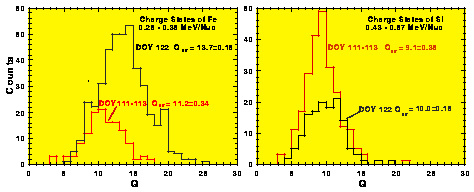


|
|
|
|
|

|
|
|
|
|
|

One key objective of the Solar Energetic Particle Ionic Charge Analyzer (SEPICA) is to measure the ionic charge states of energetic particles during individual impulsive solar flares. The figure compares the charge state distributions of Fe and Si for the solar event on May 2 (DOY 122), 1999, that showed a substantial enhancement in the abundances of Fe and 3He, with the charge states during the gradual solar event from April 20 - 23 (DOY 111-113), 1999. (For SEPICA results on 3He/4He ratios see ACE News #4.) Knowledge of the charge states and their variations will provide further insight into the acceleration and fractionation processes in these interesting solar events, which feature significant modifications of the elemental and isotopic abundances generally found in the solar atmosphere.
As can be seen from the Figure, the mean charge state of Fe is substantially higher (Qav ~ 13.7) during the impulsive event than during the earlier gradual event (Qav ~ 11.2), and the mean charge state of Si is slightly higher during the impulsive event. Higher charge states for Fe and Si are in general agreement with earlier findings using instrumentation on ISEE by Klecker et al. and Luhn et al., but the new measurements seem to indicate somewhat lower charge states than found earlier for both types of events. This may be partly due to the fact that the new measurements extend to lower energies than was possible before. We have studied several impulsive events with Qav varying between 13.7 and 14.6. If these values are interpreted as the temperature in the source region, they correspond to ~ 2-3 × 106 K as compared to ~ 1.4 × 106 K for gradual events.
It should be pointed out that the earlier results were averaged over more than 20 events observed during one year. With SEPICA about one order of magnitude more Si and Fe ions have been collected during a single solar event than with ISEE over the entire year. The excellent collecting power of the instrument will therefore make it possible for the first time to investigate temporal variations and changes of the ionic charge states with energy during individual impulsive solar events.